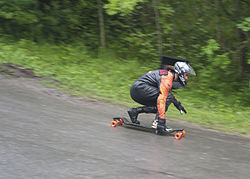Longboarding
A longboard is a type of skateboard. It is often longer than a regular skateboard. Longboard are made in many different shapes. They are often faster than regular skateboards. This is because of the size of the wheel and what the board is made of. Longboards are commonly used for cruising, traveling and downhill racing. Downhill racing is known as longboarding. Longboard 'dancing' and 'freestyle' are also popular. In this, the rider uses skateboard-like motions and steps up and down the board.
History
The first longboards were made by Preston Nichols in the 1940s and 50s. They replaced surfing when the waves were too dull. Early skaters made boards out of planks of wood and roller skates. It was called "Sidewalk Surfing".[1] Longboards were first sold in 1959. Makaha, Jack's and Hobie were the first sellers.[2] These early longboards were crude. They had wheels made of metal. Clay wheels were used later to make them safer. Longboarding became popular in the late 1950s and early 1960s. It had become much less popular by 1965. Longboarding started becoming popular again in 1972 when Frank Nasworthy and the Cadillac Wheel Company create the urethane longboard wheel.[3] Urethane wheels let skaters move much faster than they could before. Reverse kingpins(RKP) also made them more stable.
These changes made the boards more stable. They helped downhill longboarding grow into a sport. The International Gravity Sports Association (IGSA) was its governing body.[4] The cutout deck was added in the 1990s. It had sections cut out around the wheels. This stopped the wheels from touching the board during hard turns. There has been many changes to longboard technology because of the many different ways people ride them. Modern longboard decks can be made from many materials. These include fiberglass composites, aluminum and carbon fiber.
Dimensions
Most boards are 84 to 150 centimeters (33 to 59 in) in length. Widths vary from 22.8 to 25.4 cm (9.0 to 10.0 in). Longboard are made in many shapes. These include pintails, swallowtails, flat-nose riders, drop-through decks, drop decks and boards with the same shape as a regular skateboard. Pintails have looser trucks and larger wheels. They are better suited for carving or a "smooth" feel. Drop decks and drop throughs let the rider be closer to the ground. This gives them a lower center of gravity which increases stability. This also makes the boards better for downhill racing. Mid-length boards, 94 to 127 cm (37 to 50 in) have many different uses. They have more weight and bulk. This makes them move with a fluid motion by providing more momentum. The longboard's design lets rider make big turns or quick short carves. These movements are similar to the motions of surfers or snowboarders.
Longboarding Media
Downhill pack riding at Maryhill Loops Road, Washington
References
- ↑ Tadlock, Lindsay. "The History of Longboarding" (in en-US). LIVESTRONG.COM. http://www.livestrong.com/article/351382-the-history-of-longboarding/. Retrieved 2017-05-05.
- ↑ "History of Longboarding". longboardskateboard.org. Archived from the original on 2017-04-29. Retrieved 2017-05-05.
- ↑ Tony, Owen (2013-03-05) (in en-US). The Evolution Of Skateboarding – A History From Sidewalk Surfing To Superstardom. http://www.skateboardingmagazine.com/the-evolution-of-skateboarding-a-history-from-sidewalk-surfing-to-superstardom/. Retrieved 2017-05-05.
- ↑ "About Longboarding". www.topendsports.com. Retrieved 2017-05-05.





